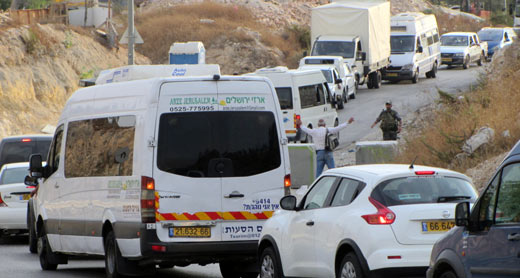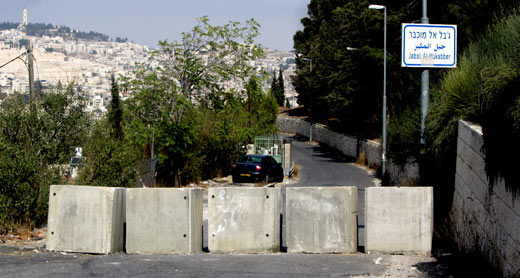Strict movement restrictions in East Jerusalem are prohibited collective punishment of Palestinians
Published:
20 Oct 2015
Updated:
21 Oct 2015
Since 14 Oct. 2015, Israeli security forces in Jerusalem have begun to impose a closure policy as decided at a cabinet meeting that day. As part of this policy, staffed checkpoints and concrete roadblocks have been put into position at various entry points to Palestinian villages and neighborhoods in East Jerusalem, as well as on internal roads. On 18 Oct. 2015, B'Tselem’s field researcher documented 35 of these (data updated on 21 Oct.):
- 21 concrete roadblocks completely preventing the passage of vehicles. Four of these roadblocks are staffed by Border Police officers who check pedestrians wishing to cross (one of these, on the road from el-‘Esawiyah to Hadassah Mt. Scopus Hospital, is made of rocks and soil and has been in place for many years, but has only recently been staffed by police officers). The remaining 16 roadblocks are not staffed.
- 14 checkpoints staffed by Border Police officers allow the passage of traffic subject to random inspections of the vehicles and passengers.
These new checkpoints and roadblocks are in addition to the 12 permanent checkpoints that divide East Jerusalem from the rest of the West Bank and from a number of East Jerusalem neighborhoods whose residents have been abandoned beyond the Separation Barrier. Over the last few days, B'Tselem has also documented several flying checkpoints in various parts of the city at which police officers have stopped traffic and inspected drivers and passengers. Yesterday, 19 Oct. 2015, Israeli media reported that certain relaxations may be introduced in the movement restrictions over the coming days and that a small number of roadblocks had already been removed.
* For technical reasons, the map does not include three roadblocks on dirt roads leading to the village of Um Tuba, another roadblock in a-Tur, and a checkpoint in Ras al-'Amud. The photo of the roadblock near Mendelbaum Gate by was taken by Ayman Fawaqa of OCHA.
The large number of checkpoints and roadblocks now in place throughout East Jerusalem seriously disrupt the daily routine of about 300,000 Palestinians who live there. Although the closure is not hermetic, in most areas it channels all traffic onto alternative routes, creating many traffic jams. In the al-‘Esawiyah neighborhood, which is home to over 15,000 people, ecurity forces have left only one access road open to traffic. The inspections also significantly delay traffic. As a result of all these factors, children and students arrive late for their studies and workers arrive late to work.
 Traffic jam at a staffed checkpoint in the neighborhood of a-Tur. Photo by ‘Amer ‘Aruri, B'Tselem, 18 Oct. 2015
Traffic jam at a staffed checkpoint in the neighborhood of a-Tur. Photo by ‘Amer ‘Aruri, B'Tselem, 18 Oct. 2015
Restricting the freedom of movement of all Palestinians in East Jerusalem, most of whom have no bearing on the attacks against Israelis, constitutes collective punishment that is prohibited under international law. Such punishment primarily harms the most vulnerable members of society, who find it hardest to move around, and takes a heavy toll on the residents’ livelihood and daily routine. It is an illegal and immoral approach that ignores the fact that the Palestinian residents of East Jerusalem, who live under occupation, regularly suffer grave discrimination and ongoing violation of their human rights.


هیچ نظری موجود نیست:
ارسال یک نظر